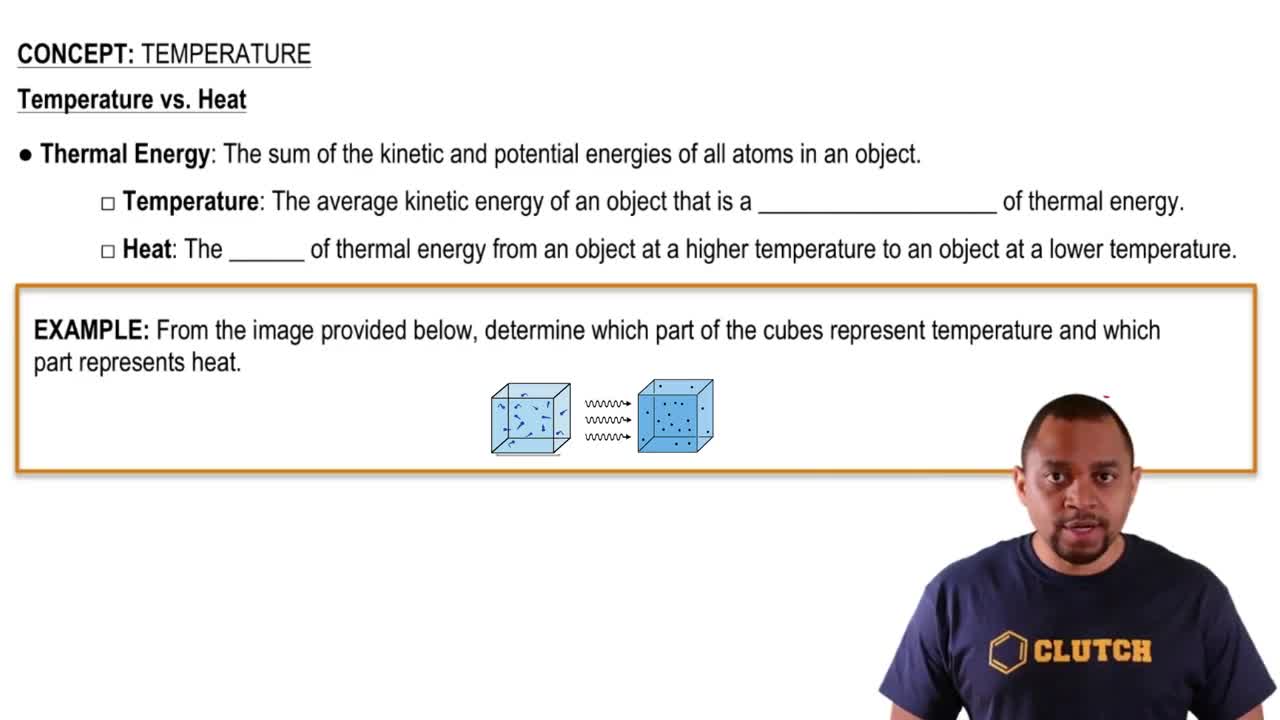(a) Which kind of intermolecular attractive force is shown in each case here? (b) Predict which of the four interactions is the weakest. [Section 11.2]
Ch.11 - Liquids and Intermolecular Forces
Chapter 11, Problem 5
If 42.0 kJ of heat is added to a 32.0-g sample of liquid meth-ane under 1 atm of pressure at a temperature of -170°C, what are the final state and temperature of the methane once the system equilibrates? Assume no heat is lost to the surroundings. The normal boiling point of methane is -161.5 °C. The specific heats of liquid and gaseous methane are 3.48 and 2.22 J/g-K, respectively. [Section 11.4]
 Verified step by step guidance
Verified step by step guidance1
Convert the heat added from kJ to J by multiplying by 1000, since 1 kJ = 1000 J.
Calculate the amount of heat required to raise the temperature of the liquid methane from -170°C to its boiling point at -161.5°C using the formula q = m * c * ΔT, where m is the mass, c is the specific heat of liquid methane, and ΔT is the change in temperature.
Determine the heat required for the phase change from liquid to gas at the boiling point using the heat of vaporization (if provided) or by considering the energy balance.
Calculate the remaining heat after the phase change and use it to raise the temperature of the gaseous methane using the specific heat of gaseous methane and the formula q = m * c * ΔT.
Determine the final temperature of the methane by adding the temperature change of the gaseous methane to the boiling point temperature.

Verified video answer for a similar problem:
This video solution was recommended by our tutors as helpful for the problem above.
Video duration:
5mWas this helpful?
Key Concepts
Here are the essential concepts you must grasp in order to answer the question correctly.
Heat Transfer and Temperature Change
Heat transfer involves the movement of thermal energy from one object to another, which can change the temperature of a substance. The relationship between heat added (q), mass (m), specific heat capacity (c), and temperature change (ΔT) is given by the equation q = mcΔT. Understanding this concept is crucial for calculating how the temperature of the methane will change when heat is added.
Recommended video:
Guided course

Temperature vs Heat
Phase Changes and Boiling Point
Phase changes occur when a substance transitions between solid, liquid, and gas states, often involving significant energy changes. The boiling point is the temperature at which a liquid turns into vapor, and for methane, this occurs at -161.5 °C. Recognizing that the added heat may cause the methane to reach its boiling point and potentially vaporize is essential for determining its final state.
Recommended video:
Guided course

Boiling Point Elevation
Specific Heat Capacities
Specific heat capacity is the amount of heat required to raise the temperature of a unit mass of a substance by one degree Celsius (or Kelvin). Different phases of a substance have different specific heat capacities; for methane, the specific heats are 3.48 J/g-K for liquid and 2.22 J/g-K for gas. This concept is vital for calculating the temperature change of methane in both its liquid and gaseous states after heat is added.
Recommended video:
Guided course

Heat Capacity
Related Practice
Textbook Question
2
views
Textbook Question
a. Which of the molecules shown here can form dipole–dipole interactions with other molecules of the same type?
b. Which are capable of forming hydrogen bonds with other molecules of the same type? [Section 11.2]
Textbook Question
Using this graph of CS2 data, determine (a) the approximate vapor pressure of CS2 at 30°C,
Textbook Question
The molecules
have the same molecular formula (C3H8O) but different chemical structures. (b) Which molecule do you expect to have a larger dipole moment? [Sections 11.2 and 11.5]
4
views
Textbook Question
The phase diagram of a hypothetical substance is
(b) What is the physical state of the substance under the following conditions? (i) T = 150 K, P = 0.2 atm; (ii) T = 100 K, P = 0.8 atm; (iii) T = 300K, P = 1.0atm. [Section 11.6]
1
views
